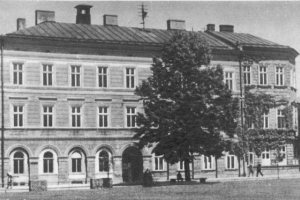Town Hall, formerly the Men’s Primery School
Town Hall, formerly the Men’s Primery School
I would like to thank all those who have made every effort to make sure this meeting could be held. I am grateful to the authorities of the district and the town of Wadowice and surrounding communities, who supported the efforts of residents with their firm commitment … Now Wadowice has a lady mayor; in my day it was Mr Mayor, Teofil Kluk.
John Paul II
Wadowice, 16 June 1999
 The history of Wadowice dates back to the fourteenth century. The town, known as ‘Oppidum’, was mentioned for the first time in an act of the feudal prince John I Scholastic in 1327. A fire in 1430 completely destroyed the town. To help the residents rebuild, the town received rights under the Kulm, or Chełmno, Law.
The history of Wadowice dates back to the fourteenth century. The town, known as ‘Oppidum’, was mentioned for the first time in an act of the feudal prince John I Scholastic in 1327. A fire in 1430 completely destroyed the town. To help the residents rebuild, the town received rights under the Kulm, or Chełmno, Law.
Wadowice reverted to the Polish Crown in 1445 and was finally incorporated by the Polish Parliament in 1564. At that time, the coat of arms of Wadowice gained a royal golden crown, and the city is proud of the title ‘The Royal Free Town of Wadowice’.
The current coat of arms of Wadowice refers to the coats of arms of the Silesian Piast Dynasty. It features the white tower of the castle of Oświęcim on a red background, and half of a golden eagle on a blue background. Crowning the whole is the golden royal crown. Beneath the shield are placed ‘the keys of Peter’, linked with a red cord.
In 1769, the city joined the Confederation of Bar. The army of Empress Maria Theresa of Austria entered the Wadowice area in 1772 as part of the First Partition of Poland. Beginning in 1777, town residents, with the approval of the Austrian Emperor, independently elected the Town Council.
The first wooden town hall was located in the center of the market square. The present municipal building, erected in 1846, has served as the seat of the town government ever since. Starting in 1875, some of the rooms were occupied by a district school, and later, between the wars, by a four-year primary school for boys. In the years 1926–1930 Karol Wojtyła was a student at this school.
In the period after World War II, in the years 1945–1990, the building housed the local authorities of the so-called people’s government. It was only after the change of the system and the first fully free and democratic elections, held on 27 May 1990, that the local government was reinstated. In place of the old National Council, which numbered 70 members, residents elected a Town Council of 28 councillors and restored the office of mayor.
Date of introduction: March 22, 2016

